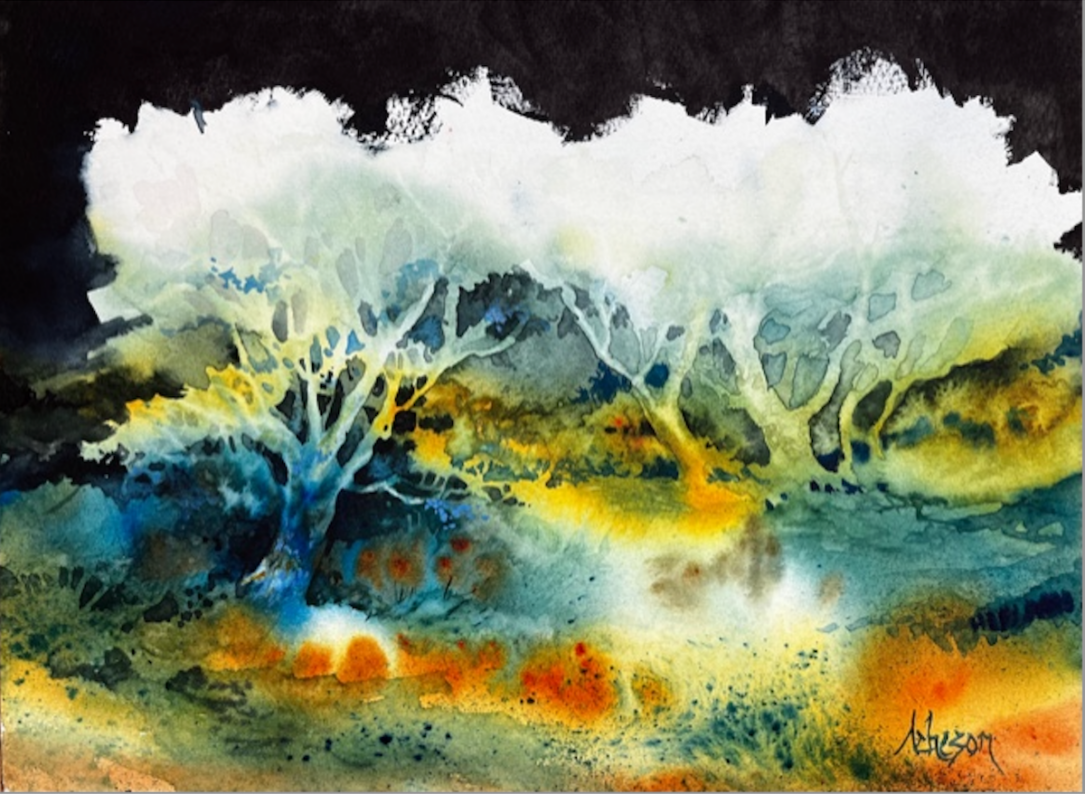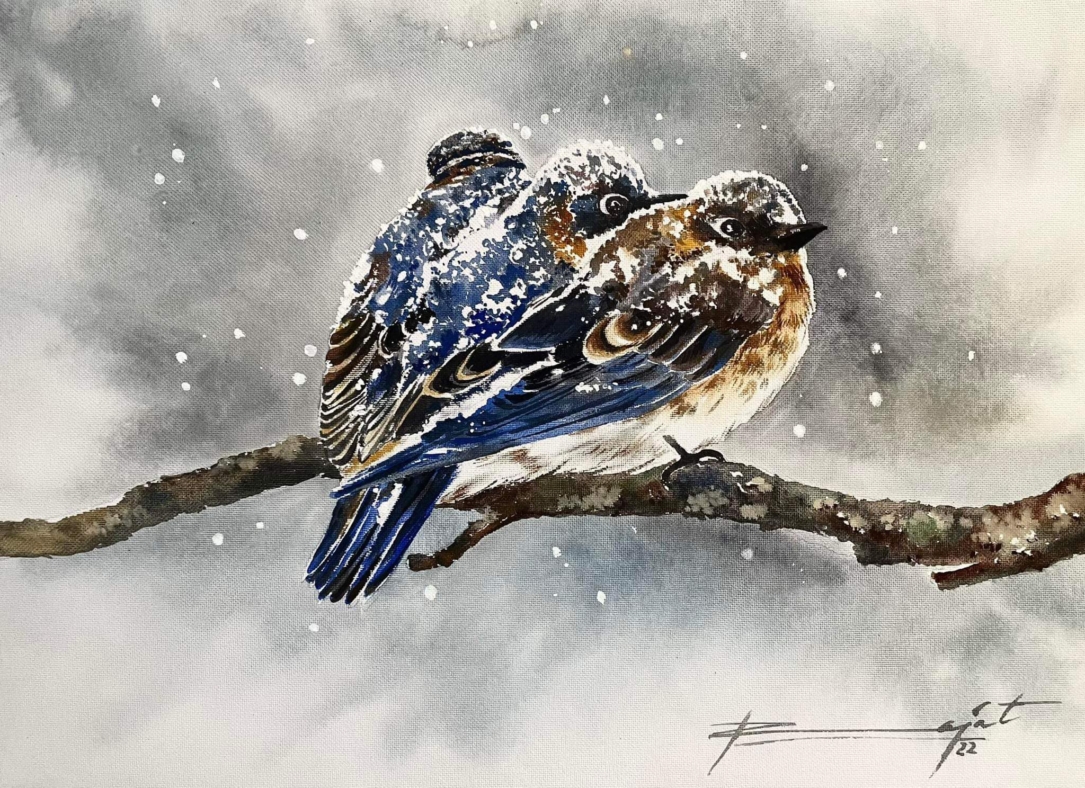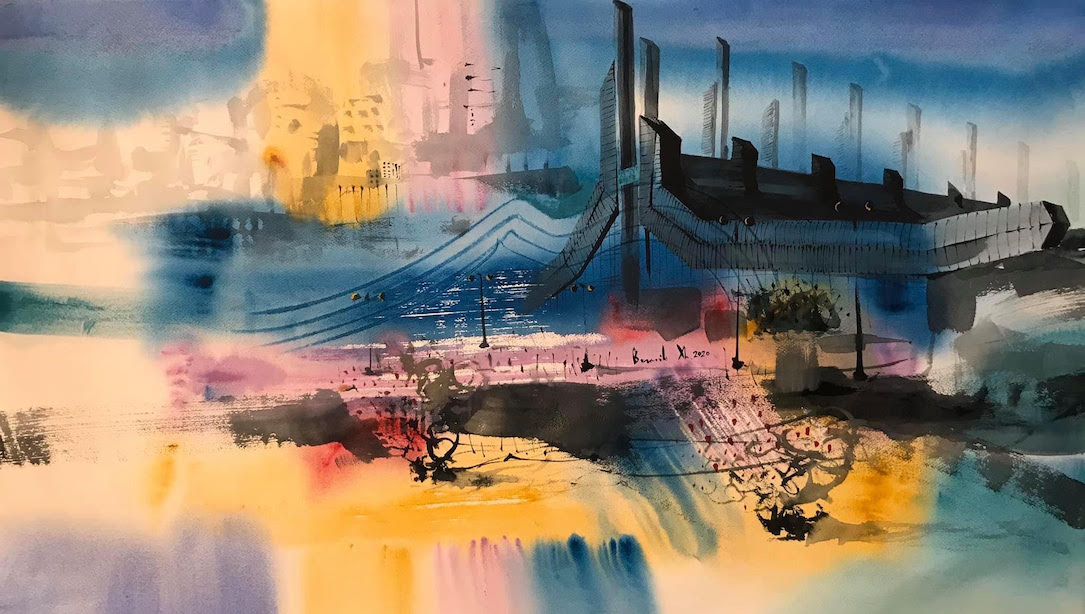Donna Acheson Juillet from France shared her favorite watercolor tips and techniques.
Here’s a Q&A with Donna:
Why do you make art?
I love to paint, to spend my days working with the water and pigments, giving them freedom to mix and mingle on their own. Then when the time is right, to encourage the pigments to go in the direction that I want. I have to paint. I see the world in colors. Even grays are colorful to me. I want to capture what I see so that I can share it. I see the world as I paint it with positive and negative shapes, hard and soft edges.
How long have you been painting?
I have been painting for 40 years and I have been teaching since 1996.
Did you have formal art training?
Like many, I have always drawn and created but I do not have formal training. When I started teaching others how to paint, I was also teaching myself to go further in my research of colors, balanced composition and creativity.
Are you a working artist or a hobbyist?
I am a professional artist, registered with the House of Artists here in France.
What inspires you?
Nature. It guides all my choices for subject matter, the way I apply paint to the paper, and my choice of colors. The beauty and fragility of nature inspires me. I am always looking for different ways to translate the feeling of wonder that I have in the face of nature.
What kind of music do you listen to while painting?
Quite often I listen to my playlist which is made up of songs from every period of my life. So we’re talking about American Pie, Supertramp, Meatloaf, Pink Floyd, The Script, Kodaline….but also some classical French songs (SOS Terrien en Détresse), songs from the movie The Way, when my daughter went off to walk the Camino. I recently went to an Eric Clapton concert, so I am now 100% into his music. My listening habits reflect my approach to painting. That is, I try to resist sticking to one type of music, much like I strive to try new ways of applying paint, choosing colors, and creating compositions. I don’t like to stay blocked in a certain category, nor do I have a recipe to ensure success. I may screw up a few paintings that way, or take a long time figuring out how to make a painting work, but that’s part of the adventure!
Have you had a mentor?
I have had 3 teachers who have influenced me. The first one was Morton Baslow from the Ottawa School of Art. We would draw for hours and then almost erase the whole drawing so that our painting was 100% pure watercolor. For years, when I was working on my creativity and composition, I forbade myself to use anything but 100% watercolor. It wasn’t because I think using inks, white, gouache, etc. is cheating, it’s just that I wanted to learn how to feel at ease with the watercolors alone – taking risks, knowing how to adjust my composition and being able to work with what was happening on the paper. My second teacher was Favard at the Beaux Arts School in Grenoble, France. Under his guidance, I started to develop my compositions – interpreting the subject and removing what’s unnecessary. Around the same time, I started taking classes with Carole Exbrayat, one of the most creative people I’ve ever met. This is when I started to delve into experimental painting. This is also the time when I started to make a lot of progress.
Do you paint every day?
I either paint every day or do something else for my painting profession, like preparing for an exhibition, wrapping up the paintings, redoing my CV, updating my artist statement or website, cleaning up my studio, preparing a workshop.
Do you paint one piece at a time or work on several at the same time?
I like to work on a couple of paintings at the same time for several reasons. First of all, it allows for the layers to dry so that I don’t have to waste too much time with the blow dryer. Secondly, I can come back to the first painting with fresh eyes and see what needs to be done more quickly. And thirdly, as I advance in the development of a painting, it gets to be quite intense. Taking a break at this time by moving onto another painting allows me to relax a little bit.
Do you create a concept piece?
Not always, it depends on the project. If I have a specific project or demo to do, I will definitely prepare a small value sketch ahead of time. During this process, I plan my whites, hard or soft edges, shapes and direction. This allows me to not only finish the painting quicker, but also plan my approach (wet on wet, dry on dry, etc.) and which technique will lead me to a balanced composition. This also helps me to paint intuitively. But sometimes I just have a very strong need to put paint on the paper, so I throw it on and invite the water and pigment to work for me. This is kind of exciting and magic because I don’t know where I’m going, but it takes me longer to finish the painting.
Do you prefer painting in studio or plein air?
I prefer to paint in the studio. However when outside, I am always looking for possible subjects and taking pictures for my studio work. I take either a zoomed version of nature for an abstract piece or for the basis of my painting or I take reference photos. I prefer to paint from pictures that I’ve taken myself.
How many core colors do you use?
For each painting, I use a very limited pallet of 2 to 5 different colors. This doesn’t mean that I stay with one combination for every single painting that I do. I am curious and I like to try out new colors and different combinations. Using a limited palette for one painting is a way for me to avoid cacophony – too much texture, too many colors, too many lines, etc. in one piece. For example, in one painting I may use only 2 complementary colors or I may use a triad, working with a variation of the primaries.
Tubes, pans or sticks?
I usually use tubes because you can get to the dark value quite quickly and they are useful when doing a creative type of painting.
Do you use masking fluid?
A year ago, I would have answered no. I either plan my white spaces ahead of time (thumbnail sketch) or create hard-edged whites using washes and negative work. But lately I have been working on a project that requires the use of masking fluid.
When do you know that your piece is finished?
I know that my painting is finished when it feels balanced. That is, when I look at it from all four sides and I don’t feel that something is missing or that there is an empty space. I quite often refer back to my thumbnail sketch to help me in my analysis.
••••••••••
Join us online each week via Zoom or Facebook for an Up Close and Personal Conversation with John Cogley (Daniel Smith Owner and CEO) along with guest artists from around the world. On Thursdays (2:00pm Pacific), John and some of our Brand Ambassadors highlight a group of colors and answer your questions. On Fridays (10:30am Pacific), a guest artist shares a demo with their favorite tips and techniques. Click here for the upcoming week’s Zoom links.
If you prefer, you can visit our Facebook page at showtime to watch live. Replays can be watched on Facebook or YouTube. La traducción al español está disponible – selecciona el canal en español en Zoom.







